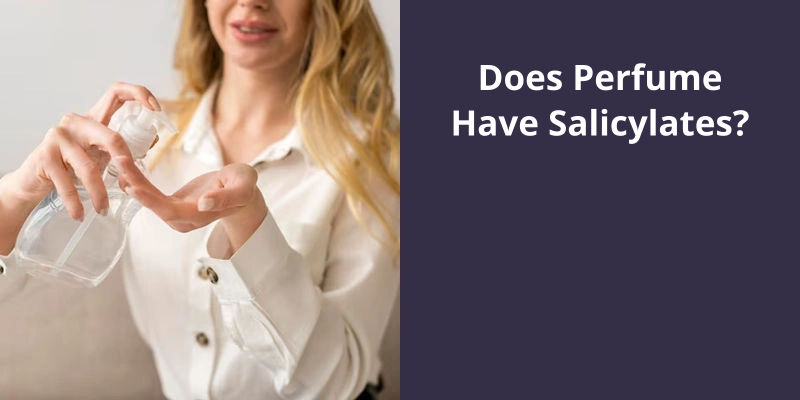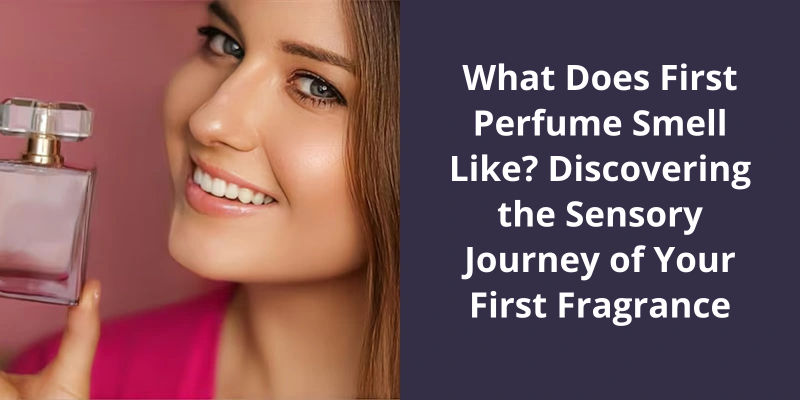Yes, perfumes often contain salicylates. Salicylates are chemicals derived from salicylic acid and are commonly used in a variety of products, including perfumes. They are used to enhance the scent of the perfume and make it last longer. Though these can cause allergic reactions for some people, they are generally considered safe in the amounts found in consumer products. However, if you are sensitive or allergic to salicylates, it is best to choose salicylate-free alternatives.

What Is the Smell of Ethyl Salicylate?
Ethyl Salicylate is a compound with a distinct sweet wintergreen odor. This fragrance ingredient is commonly used in perfumes and artificial flavorings. It’s especially prevalent in mint products, where it’s refreshing scent adds a cool and invigorating touch. However, it’s applications extend far beyond mint. Ethyl Salicylates sweet aroma makes it a popular choice in a variety of sweet formulations, including fruity and floral products.
Perfumes often utilize Ethyl Salicylate to enhance their fragrance profiles. It’s sweet wintergreen scent can add depth and complexity to a perfume, making it more captivating and alluring. Additionally, this compound can create a sense of freshness and cleanliness, making it a desirable choice for personal care and home fragrance products.
Artificial flavorings also make use of Ethyl Salicylate to recreate the taste and aroma of wintergreen. By adding this ingredient, food and beverage manufacturers can achieve a distinct sweet flavor reminiscent of minty freshness.
However, methyl salicylate isn’t solely classified as a fragrance. It’s also commonly used as a topical analgesic in medicated creams and ointments due to it’s ability to provide temporary relief from minor aches and pains. This versatile compound offers a pleasant scent, making it a popular choice for fragrances, while also possessing therapeutic properties.
Is Methyl Salicylate a Fragrance?
Methyl salicylate is a colorless or pale yellow liquid with a sweet, wintergreen odor. It’s obtained from the leaves of Gaultheria procumbens, also known as wintergreen, and is commonly used as a fragrance due to it’s pleasant scent. Because of it’s refreshing and aromatic qualities, methyl salicylate is often added to various cosmetic products to enhance their appeal and provide a soothing effect.
While methyl salicylate is primarily recognized for it’s fragrance properties, it also possesses other notable characteristics. It exhibits analgesic and anti-inflammatory properties, which make it a popular ingredient in topical pain-relieving products like muscle balms and liniments. It’s often used in these products to provide a cooling sensation and relieve minor aches and pains.
When it comes to determining if perfume contains salicylates, it’s essential to consider the specific ingredients used in the fragrance formulation. Fragrance formulations vary, and different perfume brands may opt for different ingredients to achieve their desired scent profiles.
It’s also worth noting that perfume formulations may change over time, so it’s essential to stay informed about any potential ingredient modifications.
Benzyl salicylate is a commonly used fragrance chemical known for it’s sweet and floral scent. However, when applied to the skin, it’s the potential to cause negative reactions, even in small quantities. Therefore, it’s important to be cautious when using products that contain benzyl salicylate.
What Is Benzyl Salicylate and Is It Good?
Benzyl salicylate is a fragrance ingredient commonly used in cosmetic products and perfumes for it’s pleasant scent. It’s a sweet and floral odor that adds a distinctive aroma to fragrances. However, despite it’s widespread use, benzyl salicylate can potentially cause negative reactions when applied topically, even in small amounts.
Some people may experience allergic reactions to benzyl salicylate, such as skin irritation, redness, or itching. These reactions can be more severe in individuals with sensitive skin or underlying skin conditions.
Due to it’s potential to cause allergies, benzyl salicylate is considered a sensitizing ingredient, particularly when used in high concentrations.
It’s recommended to perform a patch test before using products containing benzyl salicylate, especially if you’re trying a new fragrance or cosmetic product. Apply a small amount of the product to a small area of your skin and observe for any adverse reactions over the next 24 to 48 hours. If you experience any redness, itching, or irritation, it’s best to discontinue use.
Alternatives to Benzyl Salicylate in Fragrance and Cosmetic Products
- Cinnamyl salicylate
- Ethyl salicylate
- Methyl salicylate
- Phenethyl salicylate
- Homosalate
- Octyl salicylate
- Isoamyl salicylate
- Benzophenone-3
- Butyl methoxydibenzoylmethane
- Octocrylene
It’s important to understand the purpose of benzyl salicylate, a chemical compound that finds it’s applications in various industries such as cosmetics and domestic products. Overseas, it’s commonly utilized in different concentrations of up to 7% for it’s fragrance-enhancing properties in perfumes and personal care items. Additionally, it acts as an ultraviolet radiation absorber, providing protection from harmful sun rays. Furthermore, benzyl salicylate is incorporated into domestic products like polishes, waxes, softeners, surface treatments, air care products, as well as washing and cleaning agents.
What Is the Purpose of Benzyl Salicylate?
Benzyl salicylate, a white crystalline powder, is commonly used in various industries for it’s wide range of properties. One of it’s primary purposes is as an ingredient in cosmetic products, particularly perfumes and fragrances. It imparts a subtle, sweet, and floral aroma to these products, enhancing their overall fragrance profile. Additionally, benzyl salicylate is often utilized in personal care items like lotions, creams, and shampoos to provide a pleasant scent.
Another important use of benzyl salicylate is as an ultraviolet (UV) radiation absorber. It’s added to sunscreen and other skincare products for it’s ability to absorb UV rays, protecting the skin from potential damage caused by sun exposure. This property makes benzyl salicylate an essential component in many sun-protection formulations.
It’s worth noting that benzyl salicylate is permitted to be used in concentrations up to 7% in overseas formulations. However, regulations regarding it’s usage may vary across different countries and regions. Therefore, it’s important to consult local regulations and guidelines to ensure compliance when formulating products containing benzyl salicylate.
Benzyl salicylate, primarily known as a synthetic compound manufactured from benzyl alcohol and salicylic acid, can also be discovered in certain plants and plant extracts, including hyacinth flower oil and ylang-ylang oil.
Is Benzyl Salicylate Natural or Synthetic?
Benzyl salicylate, often used as a fragrance ingredient in perfumes and cosmetics, poses a question of it’s origin. Is it natural or synthetic? The answer lies in the chemicals production process. Generally, benzyl salicylate is derived synthetically, created through the combination of benzyl alcohol and salicylic acid. As such, it’s primarily categorized as a synthetic chemical used extensively in various industries.
Nevertheless, nature can sometimes offer surprises. While benzyl salicylate is predominantly synthetic, it can also occur naturally in specific plant species and their extracts. For example, hyacinth flower oil and ylang-ylang oil have been found to contain traces of this compound. The presence of benzyl salicylate in these natural sources may lend a unique scent to the plants or contribute to their overall chemical composition.
In terms of perfumes, the synthetic version of benzyl salicylate is more commonly employed due to it’s stability and consistency. This synthetic fragrance ingredient offers a pleasant floral aroma, often described as reminiscent of jasmine or lilac. It’s versatility and ability to blend with other fragrance components make it a popular choice for creating various fragrance profiles.
Understanding the origin and composition of this compound can aid individuals in making informed decisions about the products they use.
Perfume is a fascinating blend of natural and synthetic components, with a multitude of ingredients that come together to create it’s distinctive scent. Among the commonly used elements are benzyl alcohol, acetone, linalool, ethanol, ethyl acetate, benzaldehyde, camphor, formaldehyde, methylene chloride, and limonene. Each of these ingredients plays a unique role in the composition of perfumes, contributing to their captivating and complex olfactory profiles.
What Is the Main Ingredient in Perfume?
Perfume, the fragrant liquid that’s charmed our senses for centuries, is composed of a multitude of ingredients. From ancient times to the modern age, perfumers have explored and experimented with various substances to create unique scents. While there’s no singular main ingredient in perfume, a combination of herbal and synthetic materials forms the foundation of this olfactory delight.
When we delve into the composition of perfumes, we find a diverse array of compounds. Among the most common ingredients are benzyl alcohol, acetone, linalool, ethanol, ethyl acetate, benzaldehyde, camphor, formaldehyde, methylene chloride, and limonene. These substances contribute to the perfumes overall fragrance and help achieve a desirable balance.
Benzyl alcohol, for example, is a versatile compound that adds a sweet, floral note to perfumes. Acetone, on the other hand, is a solvent that helps dissolve and disperse other ingredients. Linalool, commonly found in lavender and rosewood oils, imparts a fresh and slightly spicy aroma to the fragrance.
Ethanol, derived from fermented plants, is the main ingredient responsible for dissolving the perfumes fragrance oils and carrying them into the air. Ethyl acetate, with it’s fruity scent, often enhances the overall composition of a perfume. Benzaldehyde lends a delightful almond-like aroma, while camphor provides a cooling and refreshing sensation.
It’s important to note that some individuals might be sensitive or allergic to certain perfume ingredients. For instance, formaldehyde, found in trace amounts, can cause skin irritation in some people. Therefore, it’s essential to read the labels and conduct patch tests before using a new fragrance.
Each component plays a distinct role in creating a unique and captivating fragrance.
The History of Perfume and It’s Evolution Over Time
Perfume has a long-standing history dating back to ancient civilizations. The art of scent-making can be traced back to the ancient Egyptians, who used fragrance in religious rituals and for personal adornment. They created scented oils and perfumes by extracting natural essences from plants, flowers, and resins.
Over time, perfume-making techniques spread across different cultures and regions. The Greeks and Romans started using perfumes for a range of purposes, including enhancing personal beauty and masking unpleasant odors. During the Middle Ages, perfumes became popular in Europe, with the creation of delicate floral scents.
In the 19th century, advancements in technology revolutionized the perfume industry. Synthetic fragrances were developed, which allowed for a greater variety of scents and increased production. Perfumes became more accessible to a wider range of people.
Today, a wide range of perfumes exists, catering to diverse tastes and preferences. Perfumes can be categorized into various scent families such as floral, oriental, woody, or fresh. They’re created using a combination of natural and synthetic ingredients, including essential oils, aromatic compounds, and fixatives.
As for salicylates, they’re naturally occurring compounds found in some plants and fruits. They can also be found in certain essential oils used in perfumes. Salicylates have been associated with allergic reactions in some individuals, so if you’ve a known sensitivity or allergy, it’s important to check the ingredient list of perfumes before use.
In conclusion, perfume has evolved throughout history, from ancient rituals to a thriving industry today. While salicylates can be present in some perfumes, it’s crucial to be cautious if you’ve any known allergies or sensitivities.
Source: Perfume Ingredients Chemicals Market: Global Industry Trend …
Conclusion
However, it’s important to note that not all perfumes contain salicylates. It’s recommended to patch test a small area of skin before applying a new perfume to the entire body to check for any adverse reactions.





